Laptop Mag Verdict
Currently the world's slimmest desktop replacement, the Razer Blade Pro doesn't sacrifice power or innovation for its incredibly good looks.
Pros
- +
Slim, sleek chassis
- +
Beautiful 4K, Nvidia G-Sync display
- +
Customizable Chroma keyboard
- +
Good overall and graphics performance
Cons
- -
Expensive
- -
Mechanical keyboard is a bit shallow
Why you can trust Laptop Mag
Razer is a feng shui master. Once again, the company has somehow managed to squeeze a whole lot of awesomeness into the Blade Pro's 0.88-inch chassis, including an Intel Core i7 processor and an Nvidia GeForce GTX 1080 GPU. As if that weren't enough, the 17-inch laptop also comes with Razer's ultra-low-profile mechanical keyboard -- a world's first -- and a 4K touch screen that uses Nvidia' G-Sync anti-tearing technology. The mind-blowing performance, sleek design and gorgeous display make the $3,699 Razer Blade Pro feel like it's worth every penny.
Design
Every time I think I'm over Razer's design, the company does something like this. It's not that the Blade Pro is a grand departure from prior Razer laptops. On the contrary, it looks just like the Blade and Blade Stealth -- just bigger. The entire frame is still made of that inky-black CNC aluminum that I've come to know and love. The lid is still defined by the emerald-green tri-snake emblem sandwiched between two subtle ridges. Yeah, it's the essentially the same laptop, except this bad boy has an Nvidia GeForce GTX 1080 CPU cleverly smuggled into its slim frame.
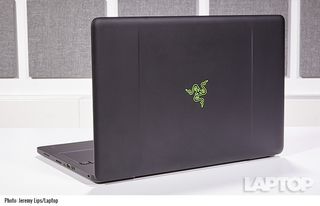
But just how slim is the Blade Pro? Weighing 7.8 pounds and measuring 16.7 x 11 x 0.88 inches, the Blade Pro is one of the slimmest, lightest desktop replacements on the market. It makes the Asus ROG G701V (8.2 pounds, 16.1 x 12.2 x 1.5 inches) look massive, and the MSI GT83VR Titan SLI (11.6 pounds, 18 x 13.3 x 1.7~2.7 inches) and Origin Eon17-SLX 10 Series (12.8 pounds, 18 x 13.3 x 1.7~2.7 inches) seem gigantic. The 7.2-pound, 16.1 x 12.2 x 1-inch Aorus X7 v6 is lighter but nowhere near as thin.
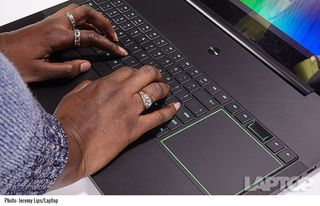
After I was done gawking at the exterior, it was time to take a look inside. Once I opened the lid, I took stock of the large, glowing keyboard with a touchpad on its right, leaving the palm rest free and clear. The power button resides at the top of the deck, while a slim pair of speakers sits along the edges of the keyboard.
On the Blade Pro's right, you'll find a USB 3.0 port, Thunderbolt 3, HDMI 2.0, a Kensington lock slot and an SD card reader, a highly useful slot that other companies are slowly phasing out. There's another pair of USB 3.0 ports on the left, along with a Gigabit Ethernet port, a headset jack and a proprietary power port.
Display
The Blade Pro's 4K (3840 x 2160) touch display is captivating, thanks to its dramatic hues and fine detail. When I watched the 4K movie Tears of Steel, I could see the fine scratches and pockmarks in the paint on a forest-green bridge. The neon-blue and pink accents in the actress's clothing popped against the blue sky and green leaves in the backdrop.
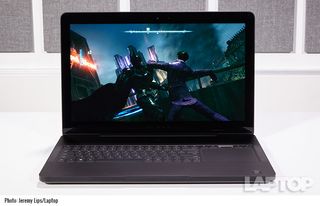
As Lara scaled a cliff in Rise of the Tomb Raider, her chestnut hair shone as the gossamer strands blew gently toward the camera. At the summit, details were sharp enough to see the grime on her red winter jacket. The vibrant coat popped against the gray winter sky as she made her way toward the next objective.
The panel can reproduce 185 percent of the sRGB color gamut, which is responsible for that luscious color. It far surpasses the 128 percent desktop-replacement average as well as the X7 v6 (114 percent), G701V (112 percent) and the Titan SLI (111 percent). The Eon17-SLX came the closest to challenging the Pro's reign, at 178 percent.
The Blade Pro's display measured 2.3 on the Delta-E color accuracy test, which is worse than the ideal score of 0 and the 1.3 category average. The Titan SLI (1.3) and the Eon17-SLX (1) were far more accurate. However, the G701V and the X7 v6 were less exact than the Blade Pro, scoring 2.4 and 3.5, respectively.
Measuring 304 nits of brightness, the Blade Pro skirted past the 298-nit average as well as the G701V and the X7 v6 (both of which hit 287 nits) and the Titan SLI (275 nits). However, the Asus ROG G752VS and the Eon17-SLX outshone the competition, with scores of 326 and 335 nits, respectively.
G-Sync
As if offering a 4K touch screen weren't enough, the Blade Pro's panel is also outfitted with Nvidia's G-Sync technology. As on other laptops, G-Sync matches the laptop's display rate with the graphics card, essentially placing a frame cap that matches the panel limit. That makes for near-instant rendering in both full-screen and windowed modes, eliminating the tearing and ghosting you sometimes experience on other laptops.
Audio
I've gotten used to ragging on Razer's quiet speakers. I didn't have to this time, though. Equipped with a dual-firing speaker system, the Blade Pro easily filled my bedroom with rich, clear audio. The two top-mounted speakers are fleshed out by a pair of slim, side-mounted speakers. The quad-speaker setup helped the system deliver a surround-sound effect.
When listening to Anderson Paak's "Am I Wrong," I was treated to the singer's velvety tenor floating over a rich keyboard, synthesized strings and lively drums. After switching among the Dolby Audio presets, I found that Gaming delivered the warmest sound overall.
Lara's grunts as she scaled cliffs or hurled herself onto an unsuspecting guard were nice and full in Rise of the Tomb Raider. Gunfights produced weighty booms, accompanied by insistent horns and frantic percussion.
Keyboard
Razer has brought its gorgeous Chroma keyboard to the Blade Pro, visually serenading my eyes with vibrant, pulsating color. Each key can produce 16.8 million colors, and because the keys are individually backlit, they radiate brilliant color in both well-lit and dim environments. But the light show doesn't stop there -- the touchpad and scroll wheel are also lined in pretty LEDs so they can join the Technicolor party.

When it was time to start typing on the island-style keyboard, I was greeted by a lovely clicking sound that can only come from a mechanical keyboard. To preserve the Blade Pro's svelteness, Razer has created the world's first ultra-low-profile mechanical keyboard, with superthin switches to match. That means those typically silent, squishy Chiclet-style key caps now sound and function like their mechanical brethren.
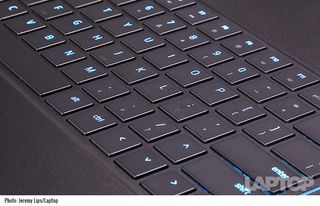
As nice as those clicks are, I wish the keys had a bit more key travel. At 0.9 millimeters (1.5 to 2 mm is optimal) and 66 grams of force needed to press the keys, typing was a rather shallow experience. I discovered I had to press harder than normal to make all of my keystrokes register. That overcompensation caused my 10fastfingers.com typing test score to drop from my usual 65 words per minute to 55 wpm.
Overall, I like what Razer has done with the switches; I just need a bit more travel for a truly comfortable experience. I'm hoping that, in subsequent iterations of the design, Razer can hit that sweet spot without having to add bulk to the overall chassis.
Touchpad and Scroll Wheel
I'm not going to lie: I'm a little disappointed that Razer got rid of the LCD touch panel/second display and Dynamic Adaptive Tactile Keys of the original Blade circa 2012 -- especially when Apple is touting its Touch Bar. But I appreciate that the Blade Pro held on to some of its predecessor's design language, keeping the rather large 4 x 3.3-inch touchpad on the right of the keyboard instead of below it, centered between the G and H keys.
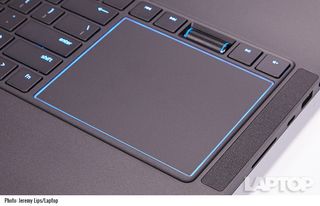
In practice, the touchpad placement does take some time to get used to. It took about 15 minutes for me to get it through my skull that pawing at the bare palm rest was not doing anything to move the cursor. Once I made peace with the change, I found the touchpad was agile and responsive when performing two-finger scroll and pinch-to-zoom gestures.
Even though the flashing LCD display is gone, that doesn't mean that Razer didn't put a little bit of innovative flair somewhere else. The scroll wheel above the touchpad can be programed for a number of functions via Razer's Synapse software, including to adjust the volume. The textured device gently grips your fingertip and offers fluid motion.
Synapse
Without Razer's Synapse app, the Chroma keyboard's jewel-like lighting wouldn't be possible. Synapse allows you to program the keyboard with those beguiling colors and patterns. The software also lets you record and program macros or track your keystrokes. Because Synapse is cloud-based, you can access your settings on any Razer device, meaning you don't have to start from scratch.
Gaming, Graphics and VR
Outfitted with an Nvidia GeForce GTX 1080 with 8GB of VRAM, the Razer Blade Pro is ready for any boss battle you can throw at it. From traditional gaming to virtual reality and video editing, the most powerful GPU on the market can do it all. The laptop scored 11 on the SteamVR Performance test, matching the Eon17-SLX (dual GTX 1080s) and beating the 9.2 desktop average. The G701V (GTX 1080) and the Titan SLI (dual GTX 1080s) weren't too far behind, at 10.9 and 10.2, respectively.
I hooked up the Oculus Rift and the new Touch controllers to the system for a round of Robo Recall. The Blade Pro handled all the teleporting and robot dissections with ease. I never experienced any lag, and I managed to beat my high score.
The Blade Pro also delivered solid numbers on traditional games, like Hitman, where the notebook notched 103 frames per second on the benchmark (Very High at 1080p), matching the Eon17-SLX's frame rate. It walloped the 80-fps average and the frame rates reached by the Titan SLI and the X7 v6, which hit 83 fps and 101 fps, respectively. The G701V ran at an impressive 109 fps.
On the Rise of the Tomb Raider test (1080p at max settings), the Blade Pro achieved 65 fps, defeating the 58-fps average and the G701V's 64 fps. However, the Titan SLI and the Eon17-SLX edged out the competition, at 79 fps and 82 fps, respectively.
Overall Performance
Equipped with a 2.6-GHz Intel Core i7-6700HQ processor, the Blade Pro stood up against my demanding multitasking needs with relative ease. Despite opening 16 tabs in Google Chrome, one of which was streaming an episode of Black Mirror, I didn't notice any lag when I started running a full system scan and switching among tabs.
The system performed admirably on our synthetic benchmarks, notching 13,406 on Geekbench 3, which measures overall performance. That score wasn't enough, however, to match the 17,348 desktop-replacement average. Outfitted with a 4.5-GHz Intel Core i7-6700K CPU, the Eon17-SLX delivered a whopping 19,929, while the 2.7-GHz Intel Core i7-6820HK-powered G701V, X7 v6 and Titan SLI achieved 16,120; 16,411; and 14,765, respectively. Keep in mind, though, that the competing rigs are utilizing overclockable processors.
On our File Transfer test, the Blade Pro's pair of 256GB M.2 PCIe solid-state drives in RAID 0 configuration duplicated 4.97GB in 13 seconds, for a transfer rate of 391.2 megabytes per second, missing the 540-MBps category average. The Eon17-SLX (dual 265GB NVMe M.2 PCIe SSD) achieved 424.1 MBps. The G701V and the Titan SLI, with their pair of 512GB PCIe SSDs, notched 636.2 MBps and 727 MBps, respectively, while the G752VS' single 256GB M.2 SSD managed to hit 848.2 MBps.
When we ran the OpenOffice Spreadsheet Macro test, the Blade Pro matched 20,000 names and addresses in 4 minutes and 6 seconds, which is slower than the 3:35 average. The Titan SLI and G752VS were neck and neck, at 3:26 and 3:23, while the Eon17-SLX pulled out the win with a time of 3:09.
Battery Life
A Core i7 CPU and an Nvidia GTX 1080 GPU do not make for long battery life. The Blade Pro lasted only 2 hours and 45 minutes on the Laptop Mag Battery Test (continuous web surfing over Wi-Fi), which is below the 4:28 desktop-replacement average. However, that's still longer than the Titan SLI and the Eon17-SLX, which survived for 1:54 and 1:25, respectively. The G752VS was the last laptop running, at 3:42.
Heat
As pretty as an all-aluminum chassis can be, it's also a big heat conductor. To combat any heating issues, Razer has created a new cooling system that features a hidden internal fan, vapor chamber and dynamic heat exchanger.
However, the laptop still got a bit warm for my taste, with the center of the keyboard measuring 103 degrees Fahrenheit, which is above our 95-degree comfort threshold. The touchpad was a bit cooler, at 98 degrees, but the undercarriage hit 113 degrees. Still, I used the laptop in my lap for more than an hour rather comfortably.
Webcam
The Blade Pro has one of the best webcams I've seen. The 1920 x 1080, 2-megapixel camera captures stills and video with brilliant color and fairly sharp detail. The test shot perfectly captured my mustard sweater as well as the knit pattern.
Software and Warranty
Razer employed a light touch on the preloaded software bundle. It added only a few apps to optimize your gaming, including Killer Network Manager, which lets you configure your Wi-Fi card so you can get optimal performance. You also get Nvidia's GeForce Experience, which has a suite of game-centric software, including Shadowplay recording software. Game Optimization automatically tweaks in-game settings to get the best performance and frame rates.
You'll see only a few bloatware apps, including Facebook, Royal Revolt 2, Twitter and Drawboard PDF. Buyers of the system also will be eligible for a free download of FL Studio 12 Producer Edition, a professional music production suite.
Configurations
I had a blast reviewing the $3,699 starting configuration of the Razer Blade Pro, which has a 2.6-GHz Intel Core i7-6700HQ processor, 32GB of RAM, a pair of 256GB M.2 PCIe SSDs in RAID 0 configuration and an Nvidia GeForce GTX 1080 GPU with 8GB of VRAM. If that's not enough storage, you can get either two 512GB SSDs or a pair of 1TB M.2 PCIe SSDs in RAID 0 configuration for $3,999 or $4,499, respectively.
Bottom Line
Razer never fails to impress. Targeting gamers and creative professionals, the Razer Blade Pro is a VR-ready titan that can make the jump from VR, to traditional gaming, to video editing at the drop of a hat, thanks to its Core i7 processor and Nvidia 1080 GPU. At 0.88 inches and 7.8 pounds, it's actually a fairly portable system, given the screen size and powerful components.
Razer clearly wasn't satisfied with simply making a thin notebook. Instead, the company pushed boundaries and innovated, adding a dual-firing speaker system and a mechanical Chiclet-style keyboard. The keys are a little too shallow for my taste, but the keyboard is a good first step.
The Blade Pro is a kickass laptop, but a $3,699 starting price is sure to put a serious hurting on most wallets. If you're looking to save at least some of your money, there's the $3,499 Asus ROG G701V, which has an overclockable CPU, a powerful 1080 GPU and a 1080p G-Sync display with incredibly generous viewing angles. However, for a true mix of power and portability, the Razer Blade Pro should be on your short list.
Razer Blade Pro (December 2016) Specs
| Bluetooth | Bluetooth 4.1 |
| Brand | Razer |
| CPU | 2.6-GHz Intel Core i7-6700HQ processor |
| Card Slots | 2-1 card reader |
| Company Website | www.razerzone.com |
| Display Size | 17.3 |
| Graphics Card | Nvidia GeForce GTX 1080 GPU |
| Hard Drive Size | Dual 256GB |
| Hard Drive Speed | n/a |
| Hard Drive Type | PCIe SSD |
| Native Resolution | 3840 x 2160 |
| Operating System | Windows 10 Home |
| Optical Drive | None |
| Optical Drive Speed | n/a |
| Ports (excluding USB) | Proprietary, Headset, HDMI 2.0, Gigabit Ethernet, microSD |
| RAM | 32GB |
| Size | 16.7 x 11 x 0.88 inches |
| Touchpad Size | 4 x 3.3 inches |
| USB Ports | 4 |
| Video Memory | 8GB |
| Weight | 7.8 pounds |
| Wi-Fi | 802.11ac |
| Wi-Fi Model | Killer Wireless AC-1535 |

Sherri L. Smith has been cranking out product reviews for Laptopmag.com since 2011. In that time, she's reviewed more than her share of laptops, tablets, smartphones and everything in between. The resident gamer and audio junkie, Sherri was previously a managing editor for Black Web 2.0 and contributed to BET.Com and Popgadget.